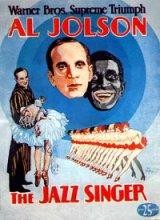Al Jolson
Location:
SCHENECTADY, New York, US
Type:
Artist / Band / Musician
Tell Me About Yourself - The SurveyMySpace Username? Al JolsonReal Name? Asa Yoelson i changed it to Al Jolson when i moved to America Birthday?May 26 1886Eye Color?BrownHair Color? BlackHeight?5' 10"Best Physical Feature?Voice Favorite Brand Clothes? Suits Favorite Vacation? I have been known to like vacationing in Mandalay or Avalon However i dont like the 1,000 Isles because I sent my wife there forever in 1913 or so i even sang on song about it Favorite Color? red Music? myself of course, Cantor anything from 1900-1929 era none of that rap Sh*t the kids listen today and they say i was a racist they should listen to that rap stuff now thats racistHighschool Sports? my family was to poor for me to go to high schoolFavorite Food? Turkey Sandwich Favorite Hobbys? Singing and cars Vanilla or Chocolate? Vanilla Do you like Thunderstorms?sure why not Do you dream?yes all the time mostly about the love i left and avalon or how i want to be in D-I-X-I-EDo you believe in ghosts or spirits?yes, I am one Favorite Holiday?my birthday it should be a holiday i was voted Americas greatist entertainerFavorite Drinks?Wine Perfect Date?Its been so long i cant rememberMarriage?I have been married 4 seperate times to Henrietta Keller, Ethel Delmar,"Ruby" Keeler and Erle Galbraith they are all dead now CREATE YOUR OWN! - or - GET PAID TO TAKE SURVEYS!
from www.Jolson.org "The man we know as Al Jolson, was born Asa Yoelson in the 1880s. (There were no birth certificates in those days although the year is generally accepted to have been 1885. He chose May 26th as his birthday because he liked the idea of being born in spring). He emigated with his family from their native villlage of Srednik in Russian Lithuania and settled in Washington DC.
His beloved mother died when he was nine, an event which haunted him throughout the rest of his life, and he and his elder brother defied their cantor father and ran away from home to seek their fortunes on the fringes of show business.
From a post-earthquake appearance at the National Theatre, San Francisco, where he first coined the phrase "You ain't seen nothin' yet", he joined a minstrel troupe and quickly made his way up the showbiz ladder until he was signed by the powerful Shubert Brothers to appear in the revue at their newly built Winter Garden Theatre (March 1911). A series of starring vehicles: Sinbad, Bombo, Big Boy, often with Jolson as Gus, his black-face comic creation, set the seal on his reputation as Broadways most charismatic performer.
He also appeared in a string of Sunday Night concerts at the Winter Garden, because he considered that was the only way fellow showbiz people could see their 'master' at work.
In 1927 Jolson played the lead in the Jazz Singer, which had been a hit broadway show starring George Jessel who had hoped to get the role for himself, but Jolson was a sensation and the success of the first recognisable talkie saved Warner Bros. from bankruptcy.
A grateful Holllywood rushed him into The Singing Fool (1928) Jolson in Singing Fool with Josephine Dunn which was an even bigger box office hit - thanks to the million-selling recording of the lachrymose 'Sonny Boy'. This sentimental song was written by Jolson's frequent collaborators, Brown and Henderson as a joke. But they, like Jolson himself ended up crying all the way to the bank as the The Singing Fool grossed the enormous sum of $5.5m - only to be exceeded by Gone With The Wind, 11 years later.
In the 1930s Jolson may have been America's highest paid entertainer, earning $17,500 a week in 1932, but the decade brought him professional disappointment. The public grew tired of the formulaic films he was making at Warner Bros., and a radical change of tone to Hallelujah, I'm a Bum, for United Artists in 1933 failed to arrest the decline. He was even eclipsed by his third wife Ruby Keeler during her brief reign as Warner Bros. favorite ingenue.
His supporting roles in Rose of Washington Square (1939) and Swanee River (1940), a midly successful return to Broadway for Hold On To Your Hats (1940) and a brief cameo as himself in the Gershwin biopic Rhapsody in Blue (1944) seemed to accelerate the downward spiral. Jolson at the piano But in entertaining the troups as part of USO - United Service Organisations - Jolson recaptured his power to electrify and enchant an audience, and the runaway success of the 1946 film The Jolson Story where he supplied the singing voice to the acting of Larry Parks heralded a triumphant comeback.
He died of a heart attack in San Francisco on October 23 1950 . "
Copyright © BANDMINE // All Right Reserved
